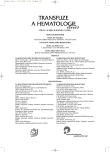Evaluation of apoptotic markers and platelet activation in apheretic harvests from plasma
Authors:
R. Procházková 1; C. Andrýs 2; L. Hubáčková 1; L. Řehořová 1; J. Krejsek 2
Authors‘ workplace:
Transfuzní oddělení, Krajská nemocnice Liberec
1; Ústav klinické imunologie a alergologie, Fakultní nemocnice Hradec Králové
2
Published in:
Transfuze Hematol. dnes,12, 2006, No. 3, p. 160-166.
Category:
Comprehensive Reports, Original Papers, Case Reports
Overview
The aim of preparation of the platelet concentrate is a mixture with conserved haemostatic function. During the process of preparation and storage, the platelet structure and function is affected. It undergoes apoptosis and activation. The state of cell damage and platelets activation was evaluated by means of separators Haemonetics MCS+ and Trima Accel with different technology of apheresis. Parameters of cell damage and platelet activation (pH, LDH, lactate, glucose, annexin V, soluble P-selectin) were evaluated at a time of preparation and expiration. The lowest level of activation during the time of preparation was observed in platelets from separator Haemonetics MCS+. Higher levels of platelet activation were demonstrated by apheresis in contrast to the total blood at the time of expiration. Mixtures from both separators showed comparable results. Based on the evaluation of progression and correlation between abovementioned markers, particularly between P-selectin and annexin V, the authors suggest that initial platelet activation in the mixtures is probably reversible. It is a result of technology procedure during the preparation, which does not affect process of apoptosis and its viability during the storage.
Key words:
apheresis, platelet activation, apoptosis
Labels
Haematology Internal medicine Clinical oncologyArticle was published in
Transfusion and Haematology Today

2006 Issue 3
Most read in this issue
- Splenectomy in diagnostics and treatment of hematological disorders: A single-center indications, complications and results
- Plasma concentrations of cytokines and co-stimulatory molecules (interleukins IL-2, IL-4, IL-5, IL-6, IL-8, IL-10, IL-13, TNF-α, TGFβ1, sCD23, sCD40L and IL-6 receptor) in healthy blood donors
- The standardization of a biochemical laboratory determination of multiple myeloma
- New approaches to diagnosis and treatment of iron overload
